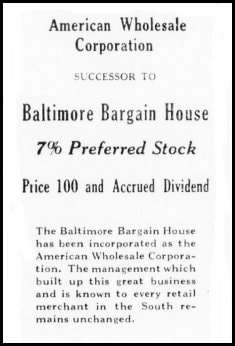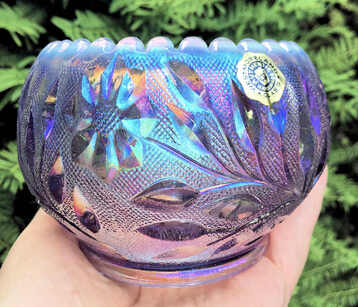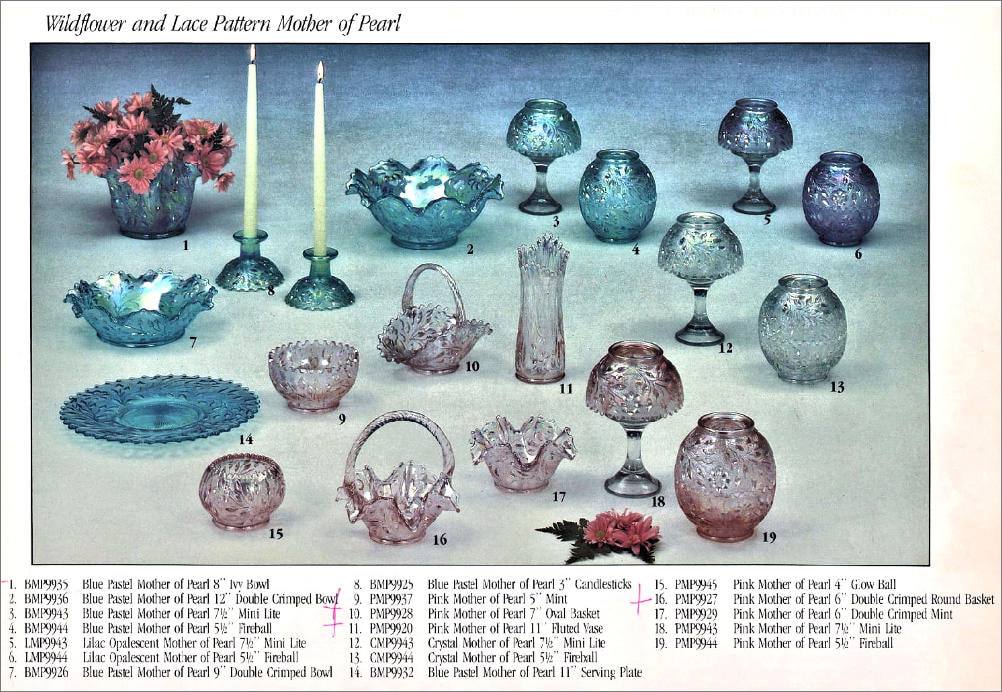NetworK ezine Issue 96. May 2023
Totally Devoted to Carnival Glass
“More Goods for Same Money” - a 1919 sales promo.
The Baltimore Bargain House was a mail order wholesale business that was founded in 1881 by Jacob Epstein and employed well over a thousand people at its height. It was said to have been one of the four largest wholesale houses in the United States. Few of the company’s catalogues appear to have survived, however one that we did get to see was iconic in its own way.
The Baltimore Bargain House was a mail order wholesale business that was founded in 1881 by Jacob Epstein and employed well over a thousand people at its height. It was said to have been one of the four largest wholesale houses in the United States. Few of the company’s catalogues appear to have survived, however one that we did get to see was iconic in its own way.
|
Some 23 years ago we were able to share a 1913 Baltimore Bargain House ad that included this "eureka!" image shown below. For the very first time, it proved conclusively that Northwood had made Rose Show and Poppy Show. Although the Carnival world had believed for years that Northwood was the maker of these two patterns, there was no actual proof, no confirmation. No pieces bore the Northwood N mark, and no catalogue illustrations had ever been found ... until our NetworK journal was published in January 2000. (You can see that full original ad and read about the discovery on our website, link at the end of this feature).
Originally the catalogues were titled “Baltimore Bargain House”, but they graduated through name changes to the “Baltimore Cost-Reducer” and then becoming the “Baltimore Price Reducer”. Above, left, the 1900 catalogue title, and right, the 1919 catalogue title.
In 1919, many US newspapers ran the ad on the right, which explained that the Baltimore Bargain House had been incorporated as the American Wholesale Corporation. Their mail order catalogue took on the new name of the “Baltimore Price Reducer” using the motto “More Goods for Same Money: Same Goods for Less Money”. The names of the catalogues had changed but the products didn’t - they continued to offer Carnival Glass. |
Above: a truly amazing Northwood Poppy Show plate
in pumpkin marigold. |
The Fenton selection below (left) appeared in the Baltimore Price Reducer in 1919, and it featured many familiar items in marigold and blue. Persian Medallion, Butterfly and Berry, Sailboats, Vintage, Holly and Orange Tree are all easily spotted. Is that a Blackberry Spray hat bottom right? The Strawberry bonbon makes an appearance as does the Open Edge Basket – and the vase looks like Butterfly and Berry.
|
In 1926, another issue of the Baltimore Price Reducer also featured Carnival – a Fenton assortment in “golden iridescent finish” (marigold). Persian Medallion, Holly and also Butterfly and Berry all make an appearance, as well as Two Flowers and an Open Edge basket in a splendid Jack-in-the-Pulpit (JIP) shape. But what is that two-handled bonbon top right? Looks like Strawberry again. The vase is Fine Rib, but what is that tightly crimped JIP hat shape to the right of the vase? It is interesting to note the promotional line for this assortment, that they were “extensively used for premiums, souvenirs etc.” Above: an Open Edge basket, Jack in the Pulpit shape in marigold. Courtesy Burns Auctions.
|
Above: a Fenton Assortment in the 1926 Baltimore Price Reducer catalogue.
Courtesy Craig Schenning and the Glass Paper Fanatics. |
|
The back cover of the 1926 Baltimore Price Reducer was fascinating to study: shown on the right, it featured an image of all the buildings apparently “owned and occupied” by the American Wholesale Corporation. The image gives the immediate impression of a massed group of structures – it looks very impressive. However, there’s a lot of artistic licence in the graphic, as revealed by the small print – “as they would appear if placed in one group”. The building at the top centre, with the signage “Main Offices Salerooms Baltimore Liberty” is the original Baltimore Bargain House edifice. When it was built in 1911 it was one of the largest commercial buildings in Baltimore – today it houses the Nancy S Grasmick (State Education) Building. Right : the back cover of 1926 Baltimore Price Reducer catalogue. Courtesy Craig Schenning and the Glass Paper Fanatics. |
Further reading: Northwood Carnival Glass including the full 1913 Baltimore Bargain House ad: The Harry Northwood Story
A May Special - "Sparkling Rubigold Iridescent Glass"
Sparkling Rubigold – we know it now, of course, as marigold, but Rubigold was Imperial's original name for their marigold iridescent colour. Note how they described it as “a red iridescent color with flashes of gold in it” in this 1915 trade ad.
Sparkling Rubigold – we know it now, of course, as marigold, but Rubigold was Imperial's original name for their marigold iridescent colour. Note how they described it as “a red iridescent color with flashes of gold in it” in this 1915 trade ad.
|
The glass was being sold directly from the Imperial factory in Bellaire. Note the stated output from the factory: a weekly capacity of over 5000 barrels (which would probably refer to all glass). Contemporaneous wholesale ads regularly refer to around 80 to 100 pieces being shipped in a barrel, so - if this statement of Imperial's capacity was not an exaggeration - it would suggest they could make some 400,000 to 500,000 pieces of glass per week! Imperial's offer in this trade ad was actually a rock-bottom deal, although the buyer had to pay shipping costs from Bellaire. The ad shows Imperial's normal $5 price for the water set before the discounted May Special price of $4.50. However, at the time, the wholesale price from Butler Brothers catalogue was 62 cents (also plus shipping), which was more expensive than the price offered in the trade ad. At around the same time, a full water set exactly as above was on offer in the Lee Mail Order (retail) catalogue for $1.50 (and then, a year later, that price had doubled). Montgomery Ward was offering it around a dollar for the set. Imperial Rose (aka Lustre Rose, OMN American Beauty Rose)
water set in marigold. Courtesy Burns Auctions. Left: 1915 Imperial trade ad.
Courtesy Jon D Bartell and the Glass Paper Fanatics. |
Imperial had introduced their No.489 pattern, which they called American Beauty Rose or American Beauties, around 1911-1912. They had been making Carnival since 1908, but the early patterns that they iridised were mainly the geometrics (imitation cut) that had already been in their repertoire. Around 1911, Imperial recognised that new designs – floral and figural – were needed; the American Beauty Rose line was introduced along with many others, such as Windmill, Pansy, Heavy Grape and so on.
In their regular catalogues, Imperial referred to Rubigold as their "M Ware". Their description made two important points: firstly that it was an iridescent treatment on crystal (clear) glass, and secondly, that "there are hardly two pieces totally alike".
|
Above: extract from Imperial's 1912 "General Catalog".
Right: 1912 Imperial catalogue showing the American Beauties (aka Lustre Rose) water set. Both courtesy of Jon D Bartell and the Glass Paper Fanatics. It's interesting to note that marigold was the cheapest colour for the water set at $5.00, with Azur (purple) and Helios at $5.75, and Old Gold (amber) being the most expensive at $6.15. |
We have a full feature article on this wonderful Imperial pattern, from Classic to Revival production - as well as it's Nordic "look-alike" here: Imperial's American Beauty Roses
We have a full feature article on this wonderful Imperial pattern, from Classic to Revival production - as well as it's Nordic "look-alike" here: Imperial's American Beauty Roses
|
Wildflower and Lace
Wildflower and Lace was Westmoreland’s No. 999 pattern. It had been introduced in the mid-1920s, although not made in Carnival at that time. In 1983, this exquisite pattern was revived and brought back into the Westmoreland repertoire. Right: Westmoreland’s lilac opalescent Wildflower and Lace rose bowl, Revival Carnival, 1984. It has the Westmoreland trademark moulded on the base and also has a paper label. Many Wildflower and Lace shapes were iridised – the line is shown in their 1984 catalogue, below. |
The label detail showing
the Westmoreland name. |
1984 Westmoreland catalogue page, showing the soft iridescent versions of Wildflower and Lace. Some unusual shapes were included,
such as the "fireball", which was a two-piece fairy lamp, where the top fitted onto the bottom and the whole was lit by a tea-light candle.
Image courtesy of Glass Paper Fanatics.
such as the "fireball", which was a two-piece fairy lamp, where the top fitted onto the bottom and the whole was lit by a tea-light candle.
Image courtesy of Glass Paper Fanatics.
Shortly after these items were made, Westmoreland stopped production, and the moulds were subsequently sold off. Some, including many of the Wildflower and Lace moulds were bought by Gary Levi (The Levay Distributing Company), who had had a long-standing business relationship with Westmorland. Later still, the moulds were acquired by Fenton, and (to complicate the matter even more), when Fenton closed and their mould stock was sold off, many of them were bought by Mosser.
|
Shown above is one of the Wildflower and Lace moulds that was in the Fenton closing down sale.
Courtesy of the Fenton Family and Fenton Art Glass Company. Items made by Fenton from the Wildflower and Lace moulds should all be marked with the Fenton single cursive style letter F (to indicate they were from moulds acquired from another company), so it should be easy to distinguish them from the earlier 1980s Westmoreland pieces. Fenton produced a wide range of colours in this pattern throughout the 1990s and into the 2000s, including a deep purple Carnival. Some of (but by no means all) the items Fenton made in Wildflower and Lace were Carnival. Initially, Fenton called the pattern “Wildflower and Lace” but very soon they simply called it “Lace” or "Wildflower". The bowl section of the basket (above right) was pressed from the mould shown here. The handle was applied after the top of the bowl had been ruffled. |
A 7 inch "Wildflower" basket made by Fenton in 1992 in Pink Pearl iridescent.
Courtesy of the Fenton Family). |
We have much more about Westmoreland - Classic and Revival Carnival here: Westmoreland Carnival.
Privacy and the use of your information: we only use your name and email address to send you your Carnival Glass NetworK ezine. We will not share your name or email address with anyone else, or use it for any other purpose. You can change your mind about receiving your NetworK ezine at any time by clicking the unsubscribe link at the foot of every issue, or by emailing us at [email protected]
Join us on Facebook
We invite you and your friends to join us all on NetworK's fast growing and very active Facebook Group (link is below), and if you have missed any of the previous issues of NetworK and NetworK Specials, they are all here: Back Issues.
We invite you and your friends to join us all on NetworK's fast growing and very active Facebook Group (link is below), and if you have missed any of the previous issues of NetworK and NetworK Specials, they are all here: Back Issues.




















